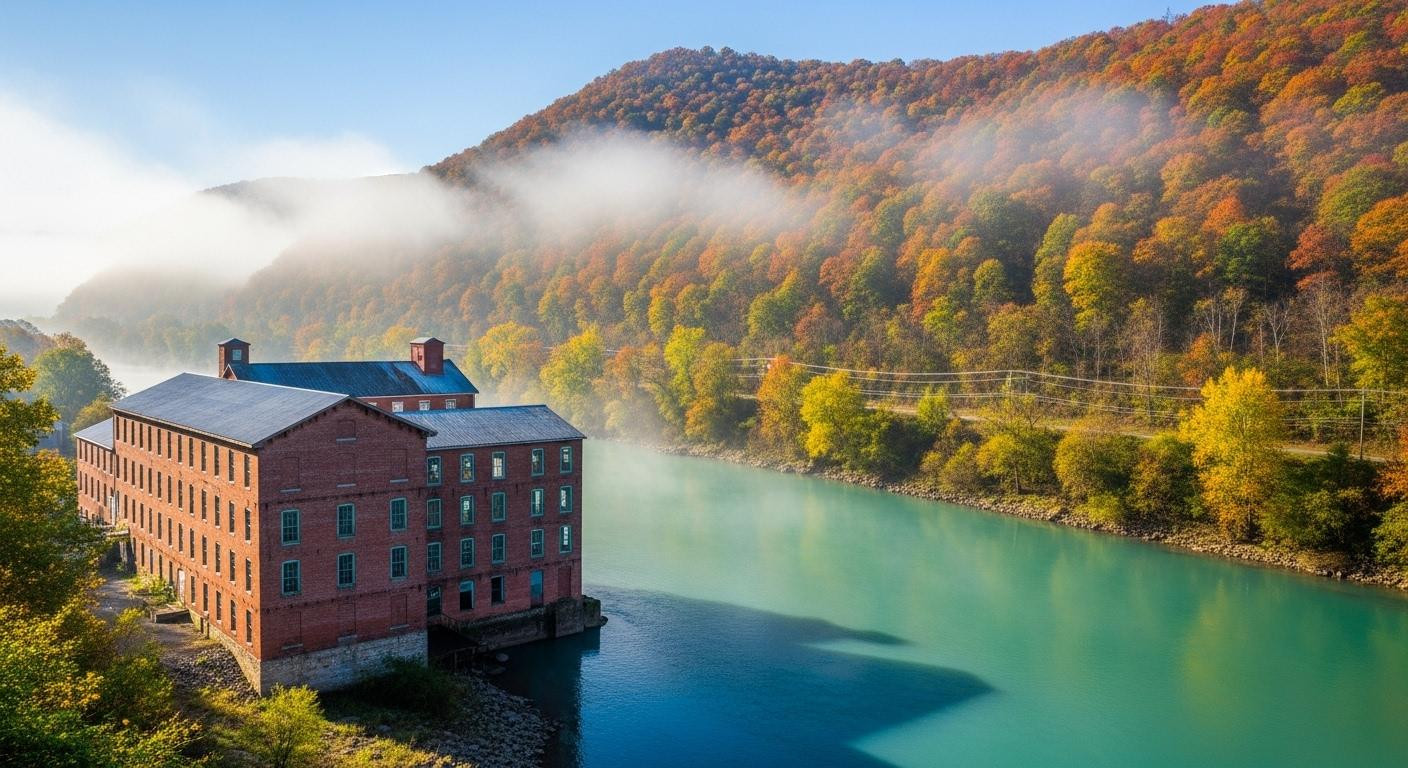Dawn breaks at 6:47 AM over Fries’ mill village as golden October light touches weathered red brick walls unchanged since Colonel Francis Henry Fries built them in 1903. A resident walks past carrying coffee from the village cafe, following morning rituals 540 residents protect. The New River flows turquoise beside 19th-century industrial buildings while morning mist lifts from Appalachian ridges at 1,300 feet elevation. This is the Virginia mill town tourists never find, named after the textile baron who changed regional industry forever.
The mill village Colonel Fries built along the New River
Reaching Fries requires intention. No interstate exits announce its presence 520 miles from New York City. The nearest Amtrak station sits 65 miles southeast in Roanoke.
Visitors arrive on winding county roads through Grayson County’s mountains. Weathered red brick buildings emerge beside the New River’s turquoise waters. Colonial Revival boarding houses built around 1905 stand unchanged.
The town covers just 0.3 square miles. Mill structures, worker housing, and the old train depot remain walkable within half a mile. Morning light reveals tan stone accents against brick facades. These under-the-radar villages preserve authenticity through geographic isolation.
What Colonel Francis Fries left behind
Colonel Francis Henry Fries (1855-1931) transformed this mountain hollow into an industrial powerhouse. The textile manufacturer and railroad executive founded the Washington Mills Company in 1903. His vision created a self-sufficient community employing 300 workers for 85 years.
The brick that built Appalachian industry
Two Colonial Revival boarding houses anchor the preserved mill village. Built around 1905 for textile workers, they’re eligible for National Register listing. The original town plan included worker housing, commercial buildings, water service, and a social center added in 1910.
Greek Revival elements reflect the Fries family’s Winston-Salem heritage. Brick powderhouses and sturdy industrial buildings demonstrate early 20th-century mill town vernacular architecture.
From Davidson College graduate to regional powerhouse
Colonel Fries graduated Davidson College in 1873, working from laborer to superintendent. He used political influence to connect Fries to the Norfolk and Western Railroad. The Roanoke and Southern Railway prevented commercial isolation, linking mountain communities to broader markets.
His dam on the New River generated mill power. The textile plant operated until 1988, reflecting the rise and fall of American industrial manufacturing.
Walking through time in a 540-resident sanctuary
Modern Fries balances preservation with accessibility. The 57-mile New River Trail State Park begins downtown, offering hiking and biking year-round. Industrial heritage towns like this maintain authentic community connections.
Mill village tours and river walks
Guided walking tours cost $10-15 per person, exploring preserved boarding houses and mill foundations. The New River offers kayaking and tubing rentals for $30-50. Heritage museum visits run $5-10.
Photography opportunities abound at golden hour. Mill buildings at sunset create dramatic silhouettes. Morning mist over the river provides ethereal scenes.
Appalachian tables and textile stories
Local diners serve traditional Appalachian fare for $10-20. Fresh trout, cornbread, country ham, and homemade pies dominate menus. Family-run establishments maintain recipes passed down through mill worker generations.
Artisan shops occupy former mill buildings. Small towns with unique histories preserve traditional crafts through local artisans. Woodworking, quilting, and pottery maintain Appalachian methods.
What 15,000 annual visitors find that Asheville’s millions miss
Fries attracts 15,000 visitors yearly compared to Asheville’s overwhelming tourist masses. Accommodation averages $70-150 per night, 15% below Virginia’s small-town rates. Major Appalachian destinations command $200+ nightly.
October delivers peak fall foliage with vibrant colors and mild 60-70°F temperatures. October timing offers optimal weather without summer heat or winter isolation. Morning silence along the New River provides contemplative moments impossible in commercialized areas.
The 540 residents maintain authentic community rhythms. Industrial heritage remains lived experience rather than staged attraction.
Your questions about Fries, Virginia answered
When is the best time to visit Fries for fall colors and fewer crowds?
October offers peak autumn foliage with temperatures reaching 60-70°F. Vibrant oranges, reds, and golds paint surrounding hills. Tourist presence remains minimal compared to mainstream Appalachian destinations. Morning mist creates optimal photography conditions.
What makes Fries’ industrial heritage different from other mill towns?
Fries preserves an intact early 1900s mill village with original Colonial Revival boarding houses. The town’s National Register eligibility reflects authentic architectural preservation. Unlike staged tourist attractions, 540 residents maintain genuine community connections to textile manufacturing history.
How does Fries compare cost-wise to popular Appalachian destinations like Asheville?
Accommodation in Fries averages $70-150 per night versus Asheville’s $200+ rates. Local meals cost $10-20 compared to tourist areas charging $25-40. Activity pricing remains accessible with mill tours at $10-15 and river kayaking at $30-50.
Evening light fades from weathered brick as a shopkeeper locks her family store. She’s walked these same streets for decades, past buildings Colonel Fries raised when industry meant community. The New River flows eternal through mountain shadows. October keeps the mill town’s golden secret.
